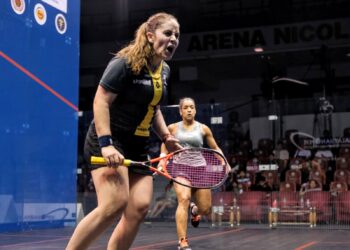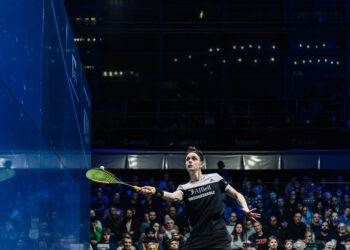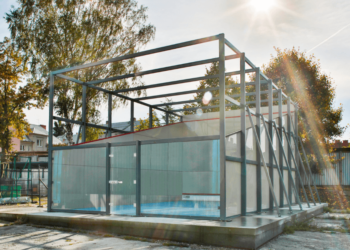I’d eyed them suspiciously before. Strange humans occasionally using our squash courts for a much slower game involving chubbier rackets and an out-of-control ball.
It looked a bit like squash, but with all the dynamism and skill stripped away. It had jokingly been written off by more than one squash friend as “squash for old people”.
Were they not aware that they could be using exactly the same space to play the most thrilling, dynamic sport around?
On the notice board of my local club, the eight names and two divisions listed on the racketball ladder were a sorry sight alongside the 50-person, nine-division squash league pinned beside it. That told me everything I needed to know about this niche game, which in 2015 officially rebranded as squash 57 (a reference to the 57mm diameter of the ball).
After lockdown forced both sets of players to hang up their rackets for two prolonged spells, it was – for reasons I fail to recall – the racketball league that reopened first in September 2021.
With squash not yet back on the menu, I decided to give this mysterious game a go, at least until my code of choice made its return.
‘The laws of physics seemed to be reversed’
I was shocked to find that I had little or no control over the ball in my first match, regularly skying it out of court on the forehand.
And that’s the first thing squash players need to know about racketball: how you hit the ball is almost as different from squash as squash is from tennis. It requires a straight arm.
The bigger, bouncier ball also had some surprises in store. My slice backhand dropshots that were winners in squash resulted in the ball dropping like a stone before it reached the front wall.
The laws of physics seemed to be reversed in the event that the ball hit a second wall, after which it would inexplicably die.
And then there were also differences of etiquette, with lets rather than strokes the order of the day if a player failed to clear their shot.
The squash leagues returned a month or so later, but with half the number of players.
By this point, the 50-shot rallies I was now having were enough to convince me that racketball had something different to offer me than squash. A gentler game, yes, but one that trended towards longer rallies and could build my endurance.
Could I successfully play both leagues side by side? Swapping between the two disciplines took some getting used to, with the squash ball unhelpfully resembling a pea each time I switched back.
50-shot rallies
But as the months went on, the transition became easier. And a full 15 months after first picking up a racketball racket, something amazing happened: I suddenly gained a semblance of control over my forehand.
An influx of racketball players orphaned from a nearby club suddenly bolstered the size of the racketball league last summer.
Now, there are 16 racketball players and four divisions. The squash league, in contrast, has failed to return to full strengths post-Covid, with around 30 players across seven divisions.
Squash remains my favourite sport, but I’m happy to admit that I was wrong to write off racketball. It is a more accessible game too, meaning it offers the squash community the best chance of attracting the more diverse intake of ages, genders and backgrounds it so badly needs.
My only advice is to get down to your local sports centre and give it a go!
The Secret Squash Player
-
The Secret Squash Player#molongui-disabled-link











